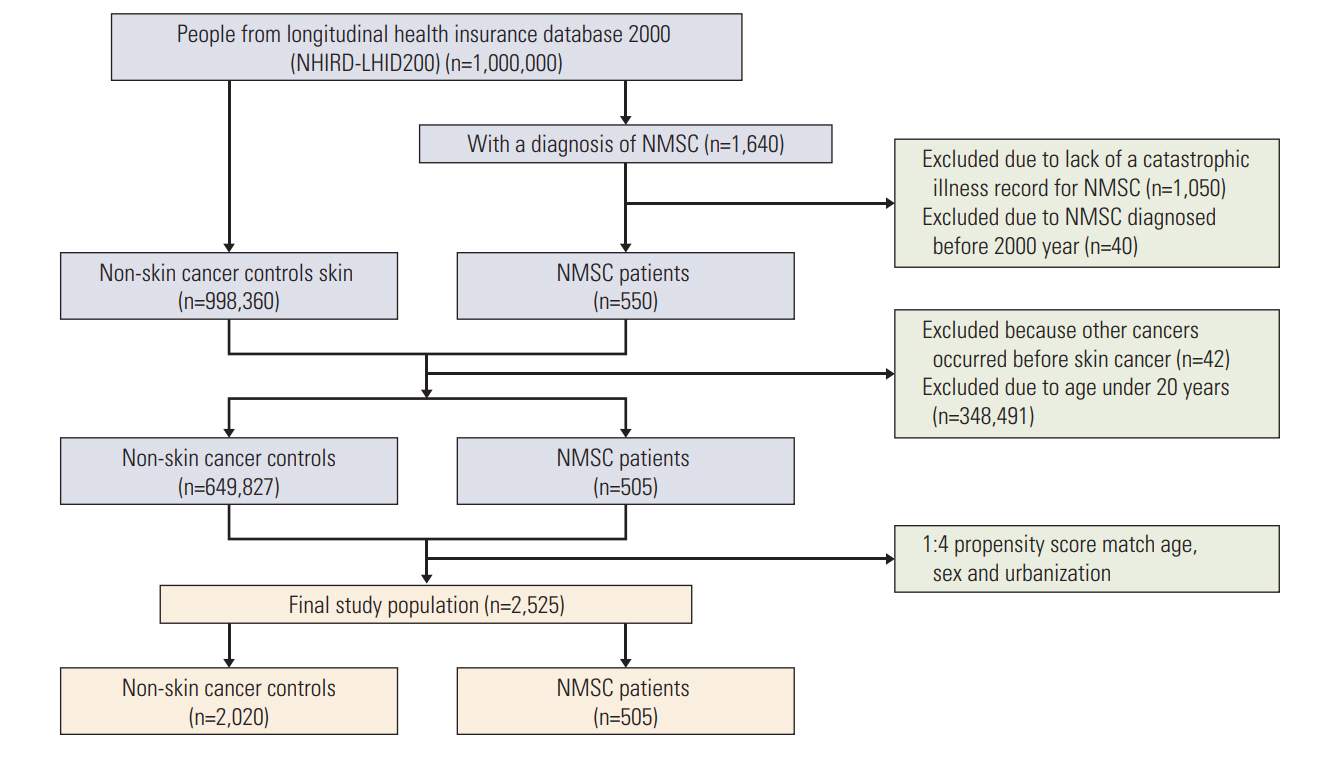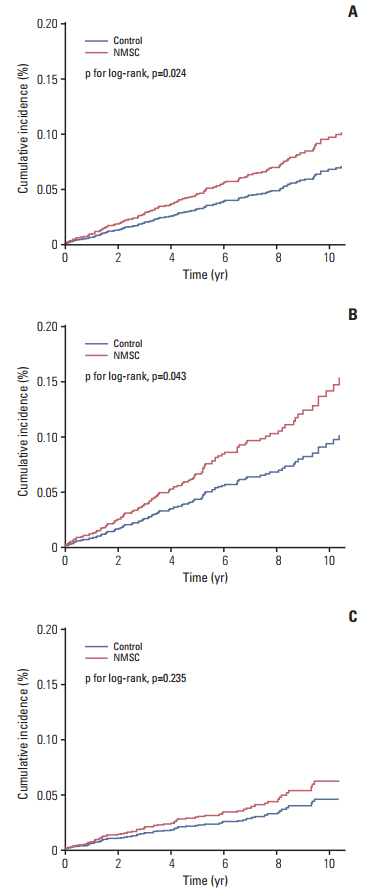Cancer Res Treat.
2018 Apr;50(2):428-435. 10.4143/crt.2017.110.
Risk of Second Primary Cancer in People with Non-melanoma Skin Cancer: A Nationwide Cohort Study
- Affiliations
-
- 1Department of Dermatology, Far Eastern Memorial Hospital, New Taipei, Taiwan.
- 2Graduate Institute of Applied Science and Engineering, College of Science and Engineering, Fu Jen Catholic University, New Taipei, Taiwan.
- 3Department of Dermatology, Chang Gung Memorial Hospital, Taoyuan, Taiwan. chingchi@cgmh.org.tw
- 4College of Medicine, Chang Gung University, Taoyuan, Taiwan.
- 5Department of Medical Research and Education, Cheng Hsin General Hospital, Taipei, Taiwan. ch2876@chgh.org.tw
- 6Department of Public Health, Fu Jen Catholic University, New Taipei, Taiwan.
- KMID: 2411132
- DOI: http://doi.org/10.4143/crt.2017.110
Abstract
- PURPOSE
Previous western studies have found Caucasians with skin cancer, either melanoma or nonmelanoma skin cancer (NMSC), have an elevated risk of second primary cancer. Our objective was to assess the risk of second primary cancer in Taiwanese with NMSC.
MATERIALS AND METHODS
By using data from Taiwan's National Health Insurance Research Database, we conducted a population-based cohort study to assess the risk of incident second primary cancer in Taiwanese affected by NMSC.
RESULTS
We identified 505 subjects with NMSC and 2,020 matched controls. After adjustment for potential confounders including age, sex, urbanization, and Charlson Comorbidity Index, people who had NMSC had a 1.43-fold (95% confidence interval [CI], 1.05 to 1.96) risk for the development of second primary cancer as comparedwith control group. Menwith NMSC had a 2.99-fold (95% CI, 1.00 to 9.10) risk for second primary cancer involving the lip, oral cavity, and pharynx and a 3.51-fold (95% CI, 1.21 to 10.17) risk for second primary cancer involving the genitourinary organs when compared to the control group. By contrast, women with NMSC did not have an increased risk of second primary cancer.
CONCLUSION
This study revealed Asians with NMSC have an increased risk of second primary cancer. Our findings can be a useful reference for health care for people diagnosed with NMSC.
Keyword
MeSH Terms
Figure
Reference
-
References
1. Chuang SC, Hashibe M, Scelo G, Brewster DH, Pukkala E, Friis S, et al. Risk of second primary cancer among esophageal cancer patients: a pooled analysis of 13 cancer registries. Cancer Epidemiol Biomarkers Prev. 2008; 17:1543–9.
Article2. Chuang SC, Scelo G, Tonita JM, Tamaro S, Jonasson JG, Kliewer EV, et al. Risk of second primary cancer among patients with head and neck cancers: a pooled analysis of 13 cancer registries. Int J Cancer. 2008; 123:2390–6.
Article3. Robsahm TE, Karagas MR, Rees JR, Syse A. New malignancies after squamous cell carcinoma and melanomas: a populationbased study from Norway. BMC Cancer. 2014; 14:210.
Article4. Song F, Qureshi AA, Giovannucci EL, Fuchs CS, Chen WY, Stampfer MJ, et al. Risk of a second primary cancer after nonmelanoma skin cancer in white men and women: a prospective cohort study. PLoS Med. 2013; 10:e1001433.
Article5. Levi F, Randimbison L, Te VC, Conconi MM, La Vecchia C. Risk of prostate, breast and colorectal cancer after skin cancer diagnosis. Int J Cancer. 2008; 123:2899–901.
Article6. Soerjomataram I, Louwman WJ, Lemmens VE, Coebergh JW, de Vries E. Are patients with skin cancer at lower risk of developing colorectal or breast cancer? Am J Epidemiol. 2008; 167:1421–9.
Article7. Hwang CY, Chen YJ, Lin MW, Chen TJ, Chu SY, Chen CC, et al. Elevated risk of second primary cancer in patients with cutaneous malignant melanoma: a nationwide cohort study in Taiwan. J Dermatol Sci. 2010; 60:167–72.
Article8. Cheng CL, Kao YH, Lin SJ, Lee CH, Lai ML. Validation of the National Health Insurance Research Database with ischemic stroke cases in Taiwan. Pharmacoepidemiol Drug Saf. 2011; 20:236–42.
Article9. Wu CS, Lai MS, Gau SS, Wang SC, Tsai HJ. Concordance between patient self-reports and claims data on clinical diagnoses, medication use, and health system utilization in Taiwan. PLoS One. 2014; 9:e112257.
Article10. Hsing AW, Ioannidis JP. Nationwide population science: lessons from the Taiwan National Health Insurance Research Database. JAMA Intern Med. 2015; 175:1527–9.11. National Health Insurance Administration. Patients with catastrophic illnesses or rare diseases [Internet]. Taipei: National Health Insurance Administration;c2017. [cited 2017 Apr 18]. Available from: http://www.nhi.gov.tw/English/webdata/webdata.aspx?menu=11&menu_id=596&webdata_id=3180&WD_ID=596.12. D'Agostino RB Jr. Propensity score methods for bias reduction in the comparison of a treatment to a non-randomized control group. Stat Med. 1998; 17:2265–81.13. Jung GW, Dover DC, Salopek TG. Risk of second primary malignancies following a diagnosis of cutaneous malignant melanoma or nonmelanoma skin cancer in Alberta, Canada from 1979 to 2009. Br J Dermatol. 2014; 170:136–43.
Article14. Charlson ME, Pompei P, Ales KL, MacKenzie CR. A new method of classifying prognostic comorbidity in longitudinal studies: development and validation. J Chronic Dis. 1987; 40:373–83.
Article15. Li B, Evans D, Faris P, Dean S, Quan H. Risk adjustment performance of Charlson and Elixhauser comorbidities in ICD-9 and ICD-10 administrative databases. BMC Health Serv Res. 2008; 8:12.
Article16. Satagopan JM, Ben-Porat L, Berwick M, Robson M, Kutler D, Auerbach AD. A note on competing risks in survival data analysis. Br J Cancer. 2004; 91:1229–35.
Article17. Efird JT, Friedman GD, Habel L, Tekawa IS, Nelson LM. Risk of subsequent cancer following invasive or in situ squamous cell skin cancer. Ann Epidemiol. 2002; 12:469–75.
Article18. Bower CP, Lear JT, Bygrave S, Etherington D, Harvey I, Archer CB. Basal cell carcinoma and risk of subsequent malignancies: a cancer registry-based study in southwest England. J Am Acad Dermatol. 2000; 42:988–91.
Article19. Rosenberg CA, Greenland P, Khandekar J, Loar A, Ascensao J, Lopez AM. Association of nonmelanoma skin cancer with second malignancy. Cancer. 2004; 100:130–8.
Article20. Chuang YC, Chuang KY. Gender differences in relationships between social capital and individual smoking and drinking behavior in Taiwan. Soc Sci Med. 2008; 67:1321–30.
Article21. Zeegers MP, Tan FE, Verhagen AP, Weijenberg MP, van den Brandt PA. Elevated risk of cancer of the urinary tract for alcohol drinkers: a meta-analysis. Cancer Causes Control. 1999; 10:445–51.22. Jemal A, Center MM, DeSantis C, Ward EM. Global patterns of cancer incidence and mortality rates and trends. Cancer Epidemiol Biomarkers Prev. 2010; 19:1893–907.
Article
- Full Text Links
- Actions
-
Cited
- CITED
-
- Close
- Share
- Similar articles
-
- Hydrochlorothiazide use and the risk of skin cancer in patients with hypertensive disorder: a nationwide retrospective cohort study from Korea
- Nationwide Trends in the Incidence of Melanoma and Non-melanoma Skin Cancers from 1999 to 2014 in South Korea
- Occupational Risk Factors for Skin Cancer: A Comprehensive Review
- Clinicopathological Study of 191 Cases of Metastatic Skin Cancers from Solid Cancer Diagnosed at the Department of Dermatology in a Tertiary Referral Cancer Center
- Primary Melanoma of the Stomach at Cardia




